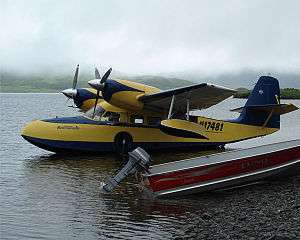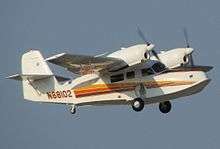Grumman G-44 Widgeon
| G-44 Widgeon | |
|---|---|
 | |
| A Grumman Widgeon on Frazier Lake on the southwest end of Kodiak Island, Alaska | |
| Role | Amphibious transport |
| Manufacturer | Grumman |
| First flight | 1940 |
| Primary users | United States Navy United States Army Air Forces United States Coast Guard Royal Navy |
| Number built | 317 (including license built French SCAN 30) |
The Grumman G-44 Widgeon is a small, five-person, twin-engine amphibious aircraft.[1] It was designated J4F by the United States Navy and Coast Guard and OA-14 by the United States Army Air Corps and United States Army Air Forces.
Design and development
The Widgeon was originally designed for the civil market. It is smaller but otherwise similar to Grumman's earlier G-21 Goose, and was produced from 1941 to 1955. The aircraft was used during World War II as a small patrol and utility machine by the United States Navy, US Coast Guard and by the Royal Navy's Fleet Air Arm.
The first prototype flew in 1940, and the first production aircraft went to the United States Navy as an anti-submarine aircraft. In total, 276 were built by Grumman, including 176 for the military. During World War II, they served with the US Navy, Coast Guard, Civil Air Patrol and Army Air Force, as well as with the British Royal Navy, who gave it the service name Gosling.
Operational history

On August 1, 1942, a J4F-1 flown by US Coast Guard Patrol Squadron 212 based out of Houma, Louisiana and flown by Chief Aviation Pilot Henry White spotted and attacked a German U-boat off the coast of Louisiana. White reported the submarine sunk, and he was subsequently credited with sinking U-166 and awarded the Distinguished Flying Cross.
However, in June 2001 the wreck of U-166 was found sitting near the wreck of SS Robert E. Lee by an oil exploration team; and the sinking of U-166 on July 30 (i.e. two days before the Widgeon flight) is now credited to patrol craft PC-566 escorting the Robert E. Lee.[2]
White's Widgeon is now thought to have made an unsuccessful attack against U-171, a Type IXC U-boat identical to U-166 that reported an air attack coincident with White's attack. U-171 was undamaged by White's attack, but was sunk four months later in the Bay of Biscay.[3]
Postwar operations
.jpg)
After the war, Grumman redesigned the aircraft to make it more suitable for civilian operations. A new hull improved its water handling, and six seats were installed. A total of 76 of the new G-44A were built by Grumman, the last being delivered on January 13, 1949. Another 41 were produced under licence by the Societe de Construction Aero-Navale (SCAN) in La Rochelle, France as the SCAN-30. Most of these ended up in the United States.
McKinnon Enterprises at Sandy, Oregon converted over 70 Widgeons to "Super Widgeons." The conversion features replacing the engines with 270 hp (201 kW) Avco Lycoming GO-480-B1D flat-six piston engines, and various other modifications, including modern avionics, three-bladed propellers, larger windows, improved soundproofing, emergency exits, and increased Maximum Takeoff Weight. Retractable wingtip floats are optional.[4]
Variants

- G-44
- Main production variant, 200 built (serial nos. 1201 - 1400) including J4F series military variants listed below.

- G-44A
- Improved postwar production variant with redesigned hull, 76 built (serial nos. 1401 - 1476.)
- J4F-1
- G-44 for the United States Coast Guard with three seats, 25 built.
- J4F-2
- United States Navy version of the J4F-1 with 5-seat interior, 131 built.

- OA-14
- Fifteen G-44s impressed into wartime service with the United States Army Air Forces.
- OA-14A
- One new aircraft for the Corps of Engineers.
- Gosling I
- Fifteen J4F-2s transferred to the Royal Navy, later renamed Widgeon I
- SCAN 30
- G-44A Licence-built in France using Metric standards and not Anodized as were original Grumman-built aircraft, 41 built (serial nos. 1 - 41.)
- PACE Gannet
Pacific Aerospace Engineering Corporation conversions of S.C.A.N. 30s, powered by 300 hp (220 kW) Lycoming R-680-13 radial engines. Later known as the Gannet Super Widgeon
Operators
Military operators
 Brazil
Brazil- Brazilian Air Force operated 14 from 1942 to 1958[5]
 Cuba
Cuba- Cuban Navy received four in 1952[6]
- Israeli Air Force operated two from 1948 to 1949[7]
 Portugal
Portugal- Portuguese Navy operated 12 from 1942 to 1968[8]
 Thailand
Thailand- Royal Thai Navy operated five in 1951[9]
- Royal Thai Air Force operated five from 1951 to 1956[9]
- United States Army Air Corps
- United States Army Air Forces
- United States Coast Guard
- United States Navy
- Civil Air Patrol
 Uruguay
Uruguay- Uruguayan Navy operated one example from 1943 to 1979[10]
Civil operators
- Mount Cook Airline
- Sea Bee Air
Survivors
Many Widgeons survive in private hands, in various states of restoration or storage. The aircraft continues to enjoy a considerable degree of popularity as a seaplane with many still being flown regularly, though rarely on the warbird circuit.
- J4F-1, USCG Aircraft Serial No. V212, National Naval Aviation Museum, Naval Air Station Pensacola, Florida[11]
- SCAN 30 serial no. 28 (reg. # CF-ODR) was on display at the Canadian Warplane Heritage Museum in Mount Hope, Ontario until it was sold to a private owner in British Columbia in 20146
- G-44 serial no. 1312 (N13122) is on display at the Alaska Aviation Heritage Museum in Anchorage, Alaska.
- Several G-44s are on display at museums in Portugal and France.
- G-44A (cn 1449) on display at the Royal Thai Air Force Museum, Bangkok, Thailand.[12]
- Ze plane! Ze plane! is seen in the opening scenes of the television series Fantasy Island delivering guests to the island. It was sold at auction on April 16, 2016[13] to an undisclosed buyer.
- Museu Aeroespacial in Rio de Janeiro, Brazil
- One flightworthy model at Brantford, Ontario.
Specifications (G-44)
Data from War Planes of the Second World War: Volume Five: Flying Boats[14]
General characteristics
- Crew: 1
- Capacity: 4 passengers (as utility aircraft)
- Length: 31 ft 1 in (9.47 m)
- Wingspan: 40 ft 0 in (12.19 m)
- Height: 11 ft 5 in (3.48 m)
- Wing area: 245 sq ft (22.8 m2)
- Empty weight: 3,240 lb (1,470 kg)
- Gross weight: 4,525 lb (2,053 kg)
- Powerplant: 2 × Ranger L-440-5 air-cooled inverted six-cylinder inline engine, 200 hp (150 kW) each
Performance
- Maximum speed: 153 mph (246 km/h; 133 kn)
- Cruise speed: 138 mph (222 km/h; 120 kn)
- Range: 920 mi (799 nmi; 1,481 km)
- Service ceiling: 14,600 ft (4,500 m)
- Rate of climb: 700 ft/min (3.6 m/s)
Armament
- Bombs: 1 × 200 lb (90 kg) depth bomb in anti-submarine role
See also
- Related development
- Aircraft of comparable role, configuration and era
- Related lists
References
- Notes
- ↑ FAA Type Certificate Number A-734; aircraft is designated a "5 PCL-Am-FbM" which means it is a 5-place Cabin Landplane-Amphibian-Flying Boat Monoplane
- ↑ ," "U-166." uboat.net. Retrieved: 18 August 2010.
- ↑ "U-171." uboat.net. Retrieved: 18 August 2010.
- ↑ Taylor 1976, p. 338.
- ↑ World Air Forces - Historical Listings Brazil (BRZ) Archived 2012-10-18 at the Wayback Machine. accessdate=30 August 2012
- ↑ World Air Forces - Historical Listings Cuba (CUB) accessdate=30 August 2012
- ↑ World Air Forces - Historical Listings Israel (ISR) accessdate=30 August 2012
- ↑ World Air Forces - Historical Listings Portugal (POR) accessdate=30 August 2012
- 1 2 World Air Forces - Historical Listings Thailand (THL) accessdate=30 August 2012
- ↑ World Air Forces - Historical Listings Uruguay (URU) accessdate=30 August 2012
- ↑ http://www.navalaviationmuseum.org/attractions/aircraft-exhibits/item/?item=j4f_widgeon
- ↑ "Building 1: Aircraft flown by RTAF after WW2." Royal Thai Air Force Museum. Retrieved: 11 January 2011. Archived 3 February 2011 at the Wayback Machine.
- ↑ "‘De plane’ from ‘Fantasy Island’ up for auction". USA Today. Retrieved 2 April 2016.
- ↑ Green 1968, p. 174.
- Bibliography
- Donald, David. The Complete Encyclopedia of World Aircraft. New York: Barnes & Noble Books, 1997. ISBN 0-7607-0592-5.
- Green, William. War Planes of the Second World War: Volume Five; Flying Boats. London: Macdonald, 1968. ISBN 0-356-01449-5.
- Taylor, John W. R. Jane's All The World's Aircraft 1976–77. London: Jane's Yearbooks, 1976. ISBN 0-354-00538-3.
External links
| Wikimedia Commons has media related to Grumman G-44. |